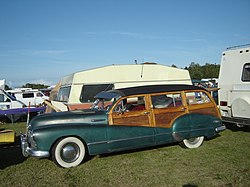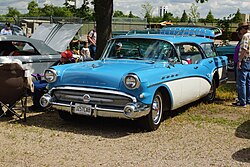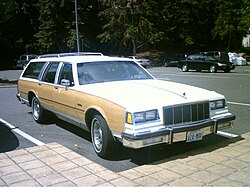Buick Estate
| Buick Estate Wagon | |
|---|---|
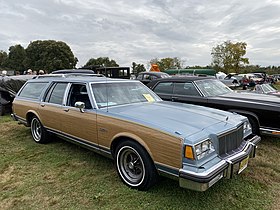 Third generation version | |
| Overview | |
| Manufacturer | Buick (General Motors) |
| Also called | Buick Super Estate Buick Roadmaster Estate Buick Special Estate Buick Invicta Estate Buick Electra Estate Buick LeSabre Estate Buick Century Estate Buick Regal Estate |
| Production | 1940-1964 1970-1996 |
| Body and chassis | |
| Class | Full-size car |
| Body style | 4-door station wagon |
| Layout | FR layout |
Buick Estate is a nameplate that was used by the Buick division of General Motors, denoting its luxury full-size station wagon from 1940 to 1964 and from 1970 to 1996. The Estate nameplate was derived from the term country estate in wealthy suburban areas and estate car, the British term for a station wagon.
For much of its model life the Buick Estate was produced using GM B platform as the station wagon counterpart of Buick sedans; it was offered on the GM C platform from 1949–1953, then again from 1971–1976. With the exception of the prewar Buick Limited limousine, the Estate was the largest vehicle of the Buick line, combining the luxury features of Buick sedans with cargo-carrying capabilities. In line with other brands having a wagon-associated moniker, Estate became adopted by other Buick wagons (regardless of size), with the exceptions of the 1964–1972 Buick Sport Wagon and the 1982–1989 Buick Skyhawk station wagon.[1][2]
Starting with model year 1947 until 1964, the Estate was offered as a station wagon on two model lines. When it returned in 1970, it was the senior station wagon to the Sport Wagon, then the name was again used on two different models in 1973 when the Sport Wagon was replaced with the intermediate-sized Buick Century Estate.[3]
As the Cadillac Division did not offer a factory-produced station wagon in North America until 2010 (the Cadillac CTS Sport Wagon), the Buick Estate served as the flagship station wagon entry from General Motors, slotted slightly above its Oldsmobile divisional counterpart, the Oldsmobile Custom Cruiser beginning in 1971. Competing against the Chrysler Town & Country and the Mercury Colony Park, the Estate was originally produced as a wooden-body station wagon ("woodie"); from 1970 to 1996, nearly all examples were fitted with simulated woodgrain exterior trim (though technically optional). The 1996 Buick Roadmaster Estate (alongside its Chevrolet Caprice counterpart) was the full-size station wagon to remain in production and the last to offer exterior woodgrain trim.[4] In 1976 American Motors Corporation introduced the Jeep Grand Wagoneer with similar passenger accommodation, luxury standard equipment and a simulated woodgrain appearance built on a dedicated chassis.
Following the 1996 model year, Buick discontinued the Roadmaster Estate and mid-size Century Estate station wagons, ending the use of the nameplate. Buick would not market another station wagon in the United States until 2018, rebranding the Opel Insignia as the Buick Regal TourX.
1940s
[edit]| 1940 Super Estate Series 50 | |
|---|---|
 1940 Buick Super Estate (Model 59) | |
| Overview | |
| Assembly | Buick City, Flint, Michigan, USA |
| Body and chassis | |
| Body style | 4-door station wagon |
| Platform | C-body (1940) (1946-1953) |
| Related | Cadillac Series 62 LaSalle Series 52 Buick Roadmaster Buick Y-Job Oldsmobile 96/98 Pontiac Custom Torpedo |
| Powertrain | |
| Engine | 248 cu in (4.1 L) Fireball Straight-eight engine OHV |
| Transmission | 3-speed sliding shift manual |
| Dimensions | |
| Wheelbase | 121.0 in (3,073 mm)[5] |
| Length | 204.0 in (5,182 mm) |
| Width | 75.8 in (1,925 mm) |
| Height | 66.0 in (1,676 mm) |
| Curb weight | 3,870 lb (1,760 kg) |
The first Buick Estate station wagon was a large-bodied 121.0 in (3,073 mm) wheelbase GM C platform Buick Super introduced mid-year only for 1940 with a wooden body, the same year the wooden-body station wagon Packard One-Ten was first introduced. The 1940 Super Estate was very exclusive and was installed with the second largest engine offered at the time, with a retail price of US$1,242 ($27,011 in 2023 dollars [6]) while the limousine Buick Limited manufactured 1,739 for a listed retail price of US$2,199 ($47,824 in 2023 dollars [6]) with similar length and interior comfort. The appearance of the wood panels using both mahogany panels with oak trim was different from other wagons that used one source of wood.[2] Production totals record that 495 found buyers at the same time the 4-door Touring Sedan sold 95,875 and 4,764 convertible coupes were made.[2] Earlier in 1934 a two-door shooting brake was offered on the Buick Series 50 by special request.[2] In 1942 all GM vehicles had an appearance upgrade where the trailing edge of the front fender was extended across the front doors that was called "Airfoil" accented by parallel chrome strips on the front and rear fenders on Buick vehicles. In later years the character line of the "Airfoil" feature was accented with a stainless-steel strip that evolved into the Buick Sweepspear for several decades.[2]
The introduction of a station wagon was a novel body style as GM first introduced it in 1939 for the Chevrolet Master, 1940 for the Oldsmobile Series 60 and 1937 for the Pontiac Streamliner and all used wooden body panels for the passenger compartment. 1935 was the year the Chevrolet Suburban carryall/panel truck was built with an all-steel body on a truck-based chassis and offered a choice of side-hinged rear panel doors, or a rear tailgate/lift window could be selected for cargo area access while only offering two side mounted doors,[7] resembling a cargo van that could seat up to eight passengers. 1937 was also the year Packard first offered a station wagon on the junior series Packard Six Model 115-C. Buick and Packard had a professional rivalry and the introduction of the Packard Station Wagon was an opportunity Buick leadership saw to offer one for Buick.[2] In 1946 the Willys Jeep Station Wagon was introduced with a similar passenger accommodation and load carrying capability.
| 1941–1942 Special Estate Series 40-B | |
|---|---|
| Overview | |
| Assembly | Buick City, Flint, Michigan |
| Body and chassis | |
| Body style | 4-door station wagon |
| Platform | GM B platform |
| Related | Cadillac Series 60 Cadillac Series 61 LaSalle Series 50 McLaughlin-Buick Buick Century Oldsmobile F-Series Oldsmobile Series 70 Pontiac Streamliner Torpedo |
| Powertrain | |
| Engine | 248 cu in (4.1 L) Fireball Straight-eight engine OHV |
| Transmission | 3-speed synchromesh manual |
| Dimensions | |
| Wheelbase | 121 in (3,073 mm) |
| Length | 208.75 in (5,302 mm) |
| Curb weight | 3,980 lb (1,805 kg) |
For 1941 and 1942, Buick switched to the GM B platform Special continuing to offer the 121 in (3,073 mm) wheelbase while the Oldsmobile Series 60 continued to use the shortest A-body. 1940 is also the year the station wagon returned to Packard on the luxurious Packard One-Twenty which also had a 122 in (3,099 mm) wheelbase.[8] The retail price for the Special Estate was US$1,463 ($30,306 in 2023 dollars [6]) and a similar production total of 838 were produced, while the Touring Sedan made 91,138.[2] In 1941 the Chrysler Windsor Town & Country station wagon was introduced shortly thereafter.[2]
Later after automobile production resumed at the end of World War II, the Estate returned to Buick's C platform Super and Roadmaster for the 1946–49 model years and a long tradition of contracting the station wagon body style was provided by Ionia Manufacturing, also known as Mitchell-Bentley Corporation[9] that today is called, Mitchell Corporation, which built all Buick station wagon bodies between 1946 and 1964 instead of GM's Fisher Body.[1]
The 1946 Super Estate was listed at US$2,594 ($40,530 in 2023 dollars [6]) and production total of 786 were produced while still offering the 121.0 in (3,073 mm) wheelbase.[1] Packard didn't offer a competitive appearance station wagon until 1948 with the Packard Station Sedan.[1]
For model year 1947, the Estate Station Wagon body style was offered on both the Super and Roadmaster models, with the Super being the more modestly equipped and the Roadmaster being the luxury version, while both offered the wooden body panels.[1]
-
1940 Buick Super Estate (Model 59) tailgate open
-
1941 Buick Special Estate (Model 49)
-
1942 Buick Special Estate (Model 49)
-
1949 Buick Super Estate (Model 59)
-
1949 Buick Super Estate interior
1950s
[edit]| Roadmaster Estate Series 70 Super Estate Series 50 Century Estate Series 60 Special Estate Series 40 | |
|---|---|
| Overview | |
| Model years | 1950-1953 1954–1958 |
| Assembly | (main plant)[10] Buick City, Flint, Michigan (branch assembly) Arlington, Texas, (Arlington Assembly) Framingham, Massachusetts, (Framingham Assembly) Kansas City, Kansas, (Fairfax Assembly) Linden, New Jersey, (Linden Assembly) South Gate, California, (South Gate Assembly) Wilmington, Delaware Doraville, Georgia |
| Body and chassis | |
| Class | Full-size car |
| Body style | 4-door station wagon 4-door hardtop station wagon |
| Layout | FR layout |
| Platform | C-body (1950-1953) B-body (1954-1958) |
| Related | Buick Special Buick Super Buick Century Buick Roadmaster Oldsmobile 88 |
| Powertrain | |
| Engine | 264 cu in (4.3 L) Fireball Straight-eight engine OHV 320 cu in (5.2 L) Fireball Straight-eight engine OHV (1950-1952) 264 cu in (4.3 L) Fireball V8 OHV 322 cu in (5.3 L) Fireball V8 OHV[10] 364 cu in (6.0 L) Fireball V8 OHV |
| Transmission | 2-speed Dynaflow automatic |
| Dimensions | |
| Wheelbase | 121.5 in (3,086 mm) (series 50 1950-53) 126.25 in (3,207 mm) (series 70 1950-53) 122 in (3,099 mm) (series 40 & 60 1954-58) |
| Length | 206.3 in (5,240 mm) (1954) 206.7 in (5,250 mm) (1955) 205.1 in (5,210 mm) (1956) 208.4 in (5,293 mm)(1957)[10] 211.8 in (5,380 mm) (1958) |
| Width | 76 in (1,930 mm) (1954–55) |
| Height | 60.5 in (1,537 mm) (1954) 59.8 in (1,519 mm) (1956)[10] |
| Curb weight | 3,940–3,995 lb (1,787–1,812 kg) |
The 1950 through 1953 Estate continued using the Super and Roadmaster "C" platform, then in 1954 to 1958 it was offered on the shorter B platform Century and Special, with all steel bodies, shared with the Oldsmobile 88.[10]
Due to the high maintenance required of the genuine wood veneer panels requiring a coat of varnish to keep the durability and appearance, the use of wood gradually decreased until 1950 when it was not much more than window surround for the exterior while more modestly used inside where the wood was protected from the elements. The Estate for 1950 was offered on the Super and Roadmaster, while the Roadmaster was offered with two trim packages called Model 79 Estate Wagon and the Model 79R Deluxe Estate Wagon, the latter offering leather upholstery, a carpeted cargo area and the first time power windows and power adjustable front seat were available.
It was installed with the largest engine available in the top-level Roadmaster, which was the Fireball Straight-eight engine that necessitated the long 126.25 in (3,207 mm) wheelbase.[1] Production numbers for both continued to be modest, with the Super Estate manufacturing 2,480 in comparison to 114,745 Super Riviera Sedan, with a listed retail price of US$2,480 ($31,406 in 2023 dollars [6]) while the Roadmaster Estate and Roadmaster Deluxe Estate had a combined production of 420 and a listed retail price of US$3,433 ($43,475 in 2023 dollars [6]) making the Deluxe Estate the most expensive Buick for that year.[1]
Production numbers of the Estate had remained small since it was introduced, and Buick changed the platform used a few times in an attempt to stimulate sales, and in 1955 the Estate had its most popular year with a combined total of 7,195, with the breakdown of 2,952 Special Estate with the last year of the 264 cu in (4.3 L) Fireball Straight-eight engine at a listed retail price of US$2,974 ($33,826 in 2023 dollars [6]) and 4,243 for the Century Special and US$3,175 ($40,208 in 2023 dollars [6]), installing the all-new 322 cu in (5.3 L) Fireball V8.[1] "Cordaveen" upholstery began to be installed in various configurations beginning in the mid-1950s with cloth inserts on higher trim packages.[3]
Later during the 50s, the fashionable hardtop body style was introduced on the Century Caballero Estate Wagons that were offered only in 1957 and 1958 and was shared with the Oldsmobile 88 Fiesta hardtop station wagon. The hardtop feature was also offered on the Special Riviera Estate Wagon and sold 6,817 with a listed retail price of US$3,167 ($34,357 in 2023 dollars [6]), while the Century Caballero Estate Wagon sold 10,186 with a listed retail price of US$3,706 ($40,204 in 2023 dollars [6]), leading in sales against the Chrysler New Yorker Town & Country and Mercury Colony Park.[1]
| Super/Special | Roadmaster/Century | Yearly Totals | |
|---|---|---|---|
| 1950 | 2,480 | 420 | 2,900 |
| 1951 | 2,212 | 679 | 2,891 |
| 1952 | 1,641 | 359 | 2,000 |
| 1953 | 1,830 | 670 | 2,500 |
| 1954 | 1,650 | 1,563 | 3,213 |
| 1955 | 2,952 | 4,243 | 7,205 |
| 1956 | 13,770 | 8,160 | 21,930 |
| 1957 | 13,200 | 10,186 | 23,386 |
| 1958 | 7,083 | 4,456 | 11,539 |
| Total | 46,818 | 30,736 | 77,564 |
-
1950 Buick Roadmaster Estate (Model 79)
-
1952 Buick Super Estate (Model 59)
-
1953 Buick Super Estate (Model 59), last of the genuine "woodies"
-
1955 Buick Special Estate (Model 49)
-
1956 Buick Special Estate (Model 49)
-
1957 Buick Century Caballero Estate Wagon (Model 69) hardtop
-
1958 Buick Century Caballero Estate Wagon (Model 69) hardtop
1960s
[edit]| LeSabre Estate Series 4400 / Invicta Estate Series 4600 | |
|---|---|
| Overview | |
| Model years | 1959–1964 |
| Assembly | |
| Body and chassis | |
| Body style | 4-door station wagon |
| Layout | FR layout |
| Platform | B-body |
| Related | Chevrolet Bel-Air Nomad Oldsmobile Dynamic 88 Fiesta Pontiac Catalina Safari |
| Powertrain | |
| Engine |
|
| Transmission | |
| Dimensions | |
| Wheelbase | 123 inches (3,100 mm) |
| Length |
|
| Width | 78.0 in (1,981 mm) |
| Curb weight | 3,969–4,505 lb (1,800–2,043 kg)[11] |
| Chronology | |
| Successor | Buick Sport Wagon |
In 1959 the LeSabre Estate was introduced on the B platform. Beginning in 1959 the intermediate Invicta Estate was offered with a listed retail price of US$3,841 ($40,146 in 2023 dollars [6]) while the junior LeSabre station wagon was listed at US$3,320 ($34,701 in 2023 dollars [6]).[3]
The Estate station wagons received a "Cordaveen" vinyl interior as standard, with the Saran Balfour cloth/Cordaveen combination interior available as an option in several colors.[12] Engines were unchanged from previous years including the standard 250-horsepower 364-cubic-inch V8, no-cost regular fuel 235-horsepower 364 or the four-barrel 300-horsepower option of same engine available at extra cost. The two-speed Turbine Drive Dynaflow automatic transmission was standard equipment on LeSabres and all other full-sized Buicks this year, although a manual transmission was also available. The three Ventiports returned to the side of the front fender denoting the junior-level status in Buick's hierarchy of products offered.[3]
The LeSabre Estate Wagon came standard with the larger 325-horsepower 401 V8 from the Wildcat and Electra 225 models. Replacing the old Dynaflow-based two-speed automatic transmission were two new Super Turbine automatics. The two-speed Super Turbine 300 (shared with the intermediate-sized cars) was available with the standard two-barrel 300 V8 while the three-speed Super Turbine 400 (shared with other big Buicks and Rivieras) was standard with the 300 four-barrel and optional with the standard engine as well as the 401 in the Estate Wagon. The standard transmission with the base 300 two-barrel V8 was a three-speed column shift manual and a four-speed manual was available as an option with either engine. The new ST300 transmission carried over the variable pitch torque converter from the Dynaflow that had been used since the mid-1950s, while the first year for the ST400 featured a fixed-pitch converter. Inside, only minor trim/upholstery revisions were made.[3]
For 1963, the Invicta series had a 6-passenger station wagon as its sole model. Only 3,495 Invicta Estate station wagons were built for 1963, after which the name disappeared, when it was replaced by the Buick Wildcat hardtop coupe or sedan. The Estate Wagon was replaced by the new, smaller A platform Buick Sport Wagon, making the B-body Chevrolet Impala Estate and Pontiac Safari the only full-sized GM station wagons until 1970.[3]
| LeSabre | Invicta | Yearly Totals | |
|---|---|---|---|
| 1959 | 8,286 | 5,231 | 13,517 |
| 1960 | 7,553 | 5,076 | 12,629 |
| 1961 | 8,051 | n/a | 8,051 |
| 1962 | n/a | 13,748 | 13,748 |
| 1963 | 9,488 | 3,495 | 12,983 |
| 1964 | 10,520 | n/a | 10,520 |
| Total | 43,898 | 27,550 | 71,448 |
-
1959 Buick LeSabre Estate
-
1963 Buick Invicta Estate
-
1964 Buick LeSabre Estate
1970
[edit]| Series 46000 | |
|---|---|
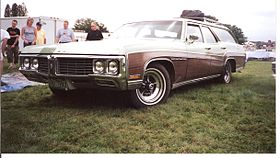 | |
| Overview | |
| Model years | 1970 |
| Assembly |
|
| Designer | Bill Mitchell |
| Body and chassis | |
| Platform | B-body |
| Related | Pontiac Bonneville Safari Chevrolet Caprice Custom Estate |
| Powertrain | |
| Engine | 455 cu in (7.5 L) Buick V8 |
| Transmission | 3-speed TH-400, automatic |
| Dimensions | |
| Wheelbase | 124.0 in (3,150 mm) |
| Length | 220.2 in (5,593 mm) |
| Curb weight | 4,900–5,000 lb (2,200–2,300 kg) |
The Buick Estate Wagon was reintroduced as the top-level luxury station wagon for GM in 1970 to compete against the Mercury Colony Park and Chrysler New Yorker Town & Country. Buick's first full-sized station wagon since 1964, it was available as a separate series on the B-body LeSabre chassis, sharing their 124.0-inch (3,150 mm) wheelbase, basic body and interior and took the senior position above the Buick Sport Wagon mid-sized station wagon.[3] From 1967 until the Estate returned in 1970, GM's most upscale full-sized station wagon offering simulated woodgrained paneling was the Pontiac Executive Safari station wagon and Chevrolet Caprice Custom Estate.[3] By special request from coachbuilders like ASC and Traditional Coachworks of Chatsworth, California the Cadillac Fleetwood was modified as a station wagon after the donor vehicle was completed.[13][14]
The Estate returned to an earlier tradition during the 1940s and 1950s of positioning it as a luxury vehicle similar to the top-level Electra 225, with full power amenities, air conditioning and the available AM/FM radio, and included an optional roof installed luggage rack with a vinyl roof covering available. To accommodate various load duties, the second row bench seat had a 60/40 split for additional passengers and cargo while using the Buick 455 V8 for effortless driving.[3] The listed retail price was US$5,047 ($39,598 in 2023 dollars [6]) and 28,306 were manufactured[3]
The LeSabre Custom's bright rocker, wheelhouse and rear lower fender moldings were used. Reviving a late 1940s "woodie" appearance Woodgrain using DI-NOC a vinyl wood-grained wrap was an option for the body sides, incorporating the traditional "Sweepspear" feature. Interiors were "Cordaveen" in the more upscale Custom trim package. Despite being on the B-body it shared the C-body division flagship Electra's luxurious accommodations and standard equipment and four VentiPorts on the front fenders. The following year the Estate would move up to Electra's larger body and more voluminous interior.[3]
Adopting the interior layout of the intermediate Sport Wagon, the Estate used a rear facing third-row seat. With a total of eight-passenger accommodation (similar to the Chevrolet/GMC Suburban of the time), the first-generation Estate wagon was among the largest vehicles ever built by Buick.[15]
| Yearly Total | |
|---|---|
| 1970 | 28,306 |
1971–1976
[edit]| Series 46000 | |
|---|---|
 1971 Buick Estate Wagon | |
| Overview | |
| Production | September 1970-August 1976 |
| Model years | 1971–1976 |
| Assembly |
|
| Designer | Bill Mitchell |
| Body and chassis | |
| Platform | C-body |
| Related | Oldsmobile Custom Cruiser Pontiac Grand Safari Chevrolet Kingswood Estate |
| Powertrain | |
| Engine | 455 cu in (7.5 L) Buick V8 |
| Transmission | 3-speed TH-400, automatic |
| Dimensions | |
| Wheelbase | 127.0 in (3,226 mm) |
| Length | 1971: 226.8 in (5,761 mm) 1972: 228.3 in (5,799 mm) 1973: 229.5 in (5,829 mm) 1974: 231.1 in (5,870 mm) 1975–76: 231.8 in (5,888 mm) |
| Width | 1971–72: 79.7 in (2,024 mm) 1973: 79.6 in (2,022 mm) 1974–76: 79.9 in (2,029 mm) |
| Height | 1971–1973: 57.3 in (1,455 mm) 1974: 57.9 in (1,471 mm) 1975: 58.4 in (1,483 mm) 1976: 57.8 in (1,468 mm) |
| Curb weight | 5,100–5,400 lb (2,300–2,400 kg) |
The 1971 to 1976 Estates were the first Buick station wagons to be built on GM longest chassis since the Roadmaster Estates of 1947–53. The Estate shared its 127.0-inch (3,230 mm) C-body wheelbase with the Electra 225, while all 1971–76 GM wagons were B-body-based per model numbers.[16] The 1971–76 GM full-size bodies, at 64.3-inch (1,630 mm) front shoulder room and 63.4-inch (1,610 mm) rear shoulder room set a record for interior width that would not be matched by any car until the full-size GM rear-wheel drive models of the early to mid 1990s. The Estate also shared the Electra 225's interior and exterior styling from 1971 to 1974 (complete with the prerequisite four VentiPorts). Door trim and seats were not as plush in 1971–74 wagons and no door pull strap was included as it was on the Electra.[3]
Although from 1975 to 1976 the number of VentiPorts were reduced by one, and the front fascia was downgraded to a LeSabre's (as was door trim and seats), the Electra 225 style chrome rocker panel moldings and distinctive Electra 225 style rear quarter panels (albeit without fender skirts) remained. The taillights were different from both the LeSabre and the Electra in all of these years. The Estate Wagons, as with other GM full-sized wagons during these years, used a rear suspension with multi-leaf springs instead of the coil springs used on other full-sized Buicks, and other full-sized GM cars to better cope with load carrying duties.[15]
The Estate Wagons also featured a new 'clamshell' tailgate design, marketed as the Glide-away Tailgate, where the rear power-operated glass slid up into the roof as the lower tailgate (manually or with power assist), slid into a recess under the cargo floor. Ultimately, the manual lower tailgate was supplanted by the power tailgate. The tailgate system was operated by switches on the instrument panel or a key switch on the rear quarter panel. Like a top-hinged tailgate, the clamshell design allowed a user to stand directly at the open cargo area without impediment, facilitating loading and unloading in tight spaces. the rear seat could be folded flat for additional cargo and incorporated a 60/40 split so that extended cargo and passengers could be accommodated and providing entry to the third row seat. Cargo capacity with the second row seats folded was 184 cubic feet.[15] If passengers were seated in the optional forward facing third row seat, the rear window could be retracted into the roof while the vehicle was in motion with the tailgate in place.
In its first year, 24,034 Estate Wagons were sold with a listed retail price of US$5,414 ($40,732 in 2023 dollars [6]).[17][3]
At 5,182 lb (2,351 kg) shipping weight, or about 5,400 lb (2,400 kg) curb weight, the three-seat 1974 Estate Wagons are easily the heaviest Buicks ever built, even heavier than the Buick Limited limousines of 1936–42. The 1975 and 1976 models were the longest station wagons ever built.[15]
The Estate used the Buick 455 V8 from 1971 through 1976 found in the Buick GSX. The Stage One high performance version, with high lift camshaft, enlarged ports, enlarged valves, and dual exhaust, was available as an option through 1974.
To commemorate the Bicentennial of the United States, the standard colors available on all Buicks were Judicial Black, Liberty White, Pewter Gray, Potomac Blue, Continental Blue, Concord Green, Constitution Green, Mount Vernon Cream, Buckskin Tan, Musket Brown, Boston Red and Independence Red, with specially available colors on select models Congressional Cream, Revere Red, Colonial Yellow and Firecracker Orange.[18]
| Yearly Total | |
|---|---|
| 1971 | 24,034 |
| 1972 | 28,968 |
| 1973 | 35,795 |
| 1974 | 14,412 |
| 1975 | 13,740 |
| 1976 | 20,374 |
| Total | 137,323 |
-
1971 Buick Estate Wagon
-
1971 Buick Estate with clamshell tailgate retracted
-
1974 Buick Estate Wagon
1977–1990
[edit]| Series 4B | |
|---|---|
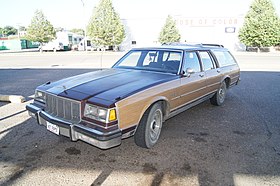 1990 Buick Estate | |
| Overview | |
| Also called | Electra Estate, LeSabre Estate |
| Model years | 1977–1990 |
| Assembly |
|
| Body and chassis | |
| Platform | B-body |
| Related | Oldsmobile Custom Cruiser Pontiac Safari Chevrolet Caprice Estate |
| Powertrain | |
| Engine | 307 cu in (5.0 L) Oldsmobile V8 350 cu in (5.7 L) Buick V8 |
| Transmission | 3-speed automatic 4-speed automatic |
| Dimensions | |
| Wheelbase | 115.9 in (2,944 mm) |
| Length | 218.8 in (5,558 mm) 220.5 in (5,601 mm) (1980–1990) |
| Width | 75.4 in (1,915 mm) 79.3 in (2,014 mm) (1980–1990) |
| Height | 57.1 in (1,450 mm) 59.5 in (1,511 mm) (1980–1990) |
In 1977, the Buick Estate was downsized and relaunched on General Motors' B-body. In 1979, an Estate Wagon Limited was offered with many previously extra cost options now included as standard in addition to the Estate Wagon. To further differentiate the Limited model, fenders included four VentiPorts (up from three) and the interior had velour upholstery with loose pillow designed seating or vinyl with leather available in later years. Production records show 21,312 were built for 1979. An appearance change was introduced for the simulated woodgrain changing from mahogany to oak which was used for several decades. Cargo capacity with the second row seats in place was 87.9 cubic feet and the core chassis elements remained in use until 1996 when the GM station wagon production was terminated.[19][4] When the Estate Wagon was introduced it had a shorter wheelbase than the 1964 Buick Sport Wagon.[3]

The tradition of luxury continued with power windows, power adjustable drivers split bench seat, six speaker stereo system, dual power adjustable side view mirrors, Touch Climate Control air conditioning, GM's Twilight Sentinel automatic headlight activation and other luxury features found on the Buick Electra.[20] The 1977 listed retail price was $6,078 ($30,560 in 2023 dollars [6]) with the optional rear facing third row seat, while the "Dual-Action" tailgate was now standard equipment with a power retractable rear window on all GM station wagons.[18]
In 1980, body changes made the wagon more aerodynamic for better fuel efficiency. Also, that year, the Electra Estate Wagon was introduced and replaced the Estate Wagon Limited while the 'base' model was now called LeSabre Estate Wagon. Exterior woodgrain applique was standard on the Electra Estate (but could be deleted for credit) and optional on the LeSabre Estate. The Buick 350 V8 engine was dropped from the options list and a 5.7 litre diesel 350 V8 was now available through 1985. The standard engine was the 5.0 litre Oldsmobile 307 V8.[19]
Although the Electra and LeSabre coupes and sedans had both switched to new front wheel drive platforms by 1986, the model names also continued to be used on the rear-wheel-drive wagons through 1989 making the Estate the largest rear wheel drive Buick offered.[18]
For 1990, which would be the Estate's final year, the Electra and LeSabre model designations were dropped, and the car was once again sold simply as the Estate Wagon. As with the Electra Estate in previous years, standard exterior woodgrain could be deleted for credit. Although the Estate Wagon model was discontinued in 1990, the Estate trim designation continued on the full-size Roadmaster station wagons from 1991 to 1996. The Estate name was also applied to the top trim level of the mid-size Century station wagon (sold as the Regal Estate station wagon in 1982 and 1983) and often included exterior woodgrain applique. Like the Roadmaster, the Century Estate continued to be sold through 1996.[18]
Production Figures
| Yearly Total | |
|---|---|
| 1977 | 25,075 |
| 1978 | 25,964 |
| 1979 | 21,312 |
| 1980 | 15,332 |
| 1981 | 11,268 |
| 1982 | 15,331 |
| 1983 | 18,887 |
| 1984 | 17,563 |
| 1985 | 13,366 |
| 1986 | 18,126 |
| 1987 | 12,759 |
| 1988 | 9,624 |
| 1989 | 7,531 |
| 1990 | 7,999 |
| Total | 220,137 |
-
1980-1989 Buick Electra Estate Wagon
-
1986 Buick Electra Estate Wagon
-
1982 Buick Electra Estate Wagon
1991–1996
[edit]| Series 4B | |
|---|---|
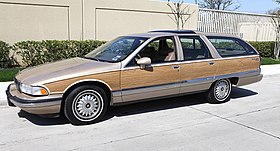 1993 Buick Roadmaster Estate Limited | |
| Overview | |
| Model years | 1991–1996 |
| Assembly | Arlington Assembly, Arlington, Texas (1994–1996) Willow Run Assembly, Ypsilanti, Michigan, U.S. (1991–1993) |
| Body and chassis | |
| Body style | 5-door station wagon |
| Layout | FR layout |
| Platform | GM B platform |
| Related | Buick Roadmaster Chevrolet Caprice Chevrolet Impala SS Oldsmobile Custom Cruiser |
| Powertrain | |
| Engine | 5.0 L L03 V8 5.7 L L05 V8 5.7 L LT1 V8 |
| Transmission | 4-speed 4L60 automatic 4-speed 4L60-E automatic |
| Dimensions | |
| Wheelbase | 115.9 in (2,944 mm) |
| Length | 217.7 in (5,530 mm) (1991–93) 217.5 in (5,524 mm) (1994–96) |
| Width | 79.9 in (2,029 mm) |
| Height | 60.3 in (1,532 mm) |
| Curb weight | 4,700 lb (2,100 kg) |
For 1991, Buick revised its nameplate offerings. The stand-alone Estate Wagon was retired, as Buick reintroduced the Roadmaster nameplate as its new full-size line (replacing the Electra, but not the Park Avenue). While last used in 1958, the Roadmaster line again offered an Roadmaster Estate station wagon for the first time since 1953.
The B-body chassis underpinnings from 1977 returned with evolutionary upgrades, with a complete redesign of the body and interior. Introduced a model year before the Roadmaster sedan, the Roadmaster Estate shared its body with the Oldsmobile Custom Cruiser and the Chevrolet Caprice station wagon.
GM discontinued the Roadmaster Estate in 1996, ending production on December 13 of that year, the last traditional full-sized American station wagon.[4] All 1996 Roadmaster Estates were installed with a "Collectors Edition" hood ornament, a round medallion in place of the traditional tri-shield Buick badge.[18]
Body design
[edit]Sharing nearly its entire body with the Custom Cruiser, both model lines were distinguished from their Chevrolet counterpart by a fixed "Vista Roof" skylight over the second row seats (a design feature revived from the 1960s Buick Sport Wagon). In contrast to the two-tone exterior paint of the Custom Cruiser, the Roadmaster Estate was styled with exterior wood paneling (notably, the 1953 Roadmaster Estate was the final factory-built American station wagon with a wooden body). Though sharing its headlights with the Caprice and the Custom Cruiser, the Roadmaster Estate was fitted with a rectangular waterfall-style grille (not shared with its sedan counterpart).
To improve aerodynamics (and fuel economy) over the previous generation, the rear of the body was styled with a sloped, semi-fastback rear windowline (similar to the 1970s "clamshell tailgate"), presenting a series of design challenges. In place of a rear hatchback door (similar to the Buick Century or the Ford Taurus station wagons), the B-body station wagons retained a two-way rear tailgate. In place of the previous retractable rear window, a hatchback rear window was installed, including a top-mounted rear windshield wiper/washer system as standard equipment.[18] For vehicles with the optional third-row (rear-facing) seat, vent windows were installed next to the D-pillars.
Powertrain
[edit]Coinciding with the 1991 redesign of the B-platform, GM retired its use of divisionally-developed engines (outside of Cadillac), with the Chevrolet small-block V8 becoming used for all GM full-size cars and light trucks. For 1991, the Roadmaster Estate was fitted with a 170hp 5.0L L03 V8; replacing the carbureted Oldsmobile 5.0L V8 (307), the new V8 brought a substantial power increase and fuel injection. For 1992, the model line adopted the 180hp 5.7L L05 V8. For 1994, the standard engine became a 5.7L sequential point fuel-injection LT1 V8, increasing output to 260hp; the Roadmaster shared this engine with the Impala SS, Caprice 9C1, and the Cadillac Fleetwood (an aluminum-head version was used by the Corvette C4, Camaro Z28, and Firebird Trans-Am). GM last offered a high-performance V8 engine in a station wagon in 1974.
Utility
[edit]When ordered with the factory towing package, the station wagon could accommodate 7,000 pounds (3,200 kg) with the use of a weight-distributing hitch, dual sway controls, setting rear tire pressure to 35 PSI, and disabling the Electronic Level Control.[21] The towing package added 2.93 rear-axle gears and a rear limited-slip differential, heavy-duty cooling system including oil and transmission coolers, and a factory-installed self-leveling rear suspension called Dynaride, which consisting of air shocks, a height sensor between the rear axle and body and an on-board air compressor. Most visibly, a pair of electric fans offset to the left under the hood was replaced by the combination of one conventional fan-driven mechanically from the engine alongside one electric fan.[18]
| Yearly Total | |
|---|---|
| 1991 | 6,729 |
| 1992 | 11,019 |
| 1993 | 9,525 |
| 1994 | 8,669 |
| 1995 | 5,522 |
| 1996 | 8,962 |
| Total | 50,426 |
-
Buick Roadmaster Estate Wagon
-
Buick Roadmaster Estate Wagon
-
1993 Estate Wagon interior
Notes
[edit]- ^ a b c d e f g h i j Flory, J. "Kelly" Jr. (2008). American Cars, 1946 to 1959; Every Model, Year by Year. McFarland & Company, Inc., Publishers. ISBN 978-0-7864-3229-5.
- ^ a b c d e f g h Kimes, Beverly (1996). standard catalog of American Cars 1805–1942. Krause publications. pp. 161–192. ISBN 0-87341-478-0.
- ^ a b c d e f g h i j k l m n o p q r s Gunnell, John, ed. (1987). The Standard Catalog of American Cars 1946–1975. Kraus Publications. pp. 50–92. ISBN 0-87341-096-3.
- ^ a b c Ward's Automotive Yearbook 1997. Ward's Communications, Inc. 1997.
- ^ "Directory Index: Buick/1940_Buick/1940_Buick_Brochure". Oldcarbrochures.com. Retrieved November 20, 2011.
- ^ a b c d e f g h i j k l m n o 1634–1699: McCusker, J. J. (1997). How Much Is That in Real Money? A Historical Price Index for Use as a Deflator of Money Values in the Economy of the United States: Addenda et Corrigenda (PDF). American Antiquarian Society. 1700–1799: McCusker, J. J. (1992). How Much Is That in Real Money? A Historical Price Index for Use as a Deflator of Money Values in the Economy of the United States (PDF). American Antiquarian Society. 1800–present: Federal Reserve Bank of Minneapolis. "Consumer Price Index (estimate) 1800–". Retrieved February 29, 2024.
- ^ 1936 to 2010 Chevrolet Suburban – My Autoworld
- ^ Kimes, Beverly (1996). Standard catalog of American Cars 1805–1942 (third ed.). Krause publications. pp. 1105–1141. ISBN 0-87341-478-0.
- ^ "Mitchell Corporation". shiawasseehistory.com. Retrieved February 22, 2022.
- ^ a b c d e Flory Jr., J. "Kelly" (2008). American Cars, 1946-1959 Every Model Every Year. McFarland. ISBN 978-0-7864-3229-5.
- ^ "1963 Buick Invicta 8 Series Estate Wagon - 2 seat". Classic Car Database. Retrieved August 5, 2016.
- ^ John Gunnell (2004). Standard Catalog of Buick, 1903-2004 (3rd ed.). Iola, WI: Krause Publications, Inc. pp. 106–107. ISBN 0-87349-760-0.
- ^ "Cadillac didn't build station wagons in 1976, but someone did". The Classic Cars Journal.com. The Collector Car Network, Inc. November 4, 2019. Retrieved March 11, 2022.
- ^ "1970 Cadillac Fleetwood Wagon Is a Rare Bird, Packs Numbers-Matching V8". Autoevolution. SoftNews Net SRL. September 9, 2021. Retrieved March 11, 2022.
- ^ a b c d "12. What was the biggest station wagon ever made?". FAQ's. Stationwagon.com. Retrieved October 7, 2013.
- ^ 1976 Buick sales brochure says wagon models are 4BR35 and 4BR45. One telltale is the lower inside door trim which was hard plastic in 1971–76 B-bodies and padded vinyl in C-bodies. Wheelbase is not a good indicator of body; check rear legroom.
- ^ Flory, J. "Kelly", Jr. American Cars 1960–1972 (Jefferson, NC: McFarland & Coy, 2004), p. 793.
- ^ a b c d e f g h i j Flammang, James M. (1999). Standard Catalog of American Cars 1976-1999 (3rd ed.). Krause Publications. pp. 43–134. ISBN 0-87341-755-0.
- ^ a b "Buick Production Figures 1950–1979". Buicks.net. Archived from the original on August 9, 2011. Retrieved April 4, 2007.
- ^ "Buick Sales brochures 1980-1989". Dezo's Garage. Dezo's Auto Group. Retrieved March 6, 2022.
- ^ "4". 1995 Buick Roadmaster Owner's Manual (First ed.). General Motors Corporation. 1994. pp. 4–34.
Sources
[edit]- Flory, J. "Kelly", Jr. American Cars 1960–1972. Jefferson, NC: McFarland & Coy, 2004.




